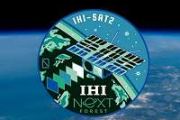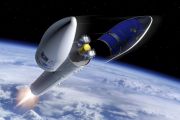
Copernical Team
With delay until 2026, Boeing Starliner next flight may not carry humans, NASA says
This request seems a bit unusual, so we need to confirm that you're human. Please press and hold the button until it turns completely green. Thank you for your cooperation!
Press and hold the button
If you believe this is an error, please contact our support team.
185.132.36.159 : 23e569f9-0f03-404c-a55f-8301a882
Moon erosion by solar wind far weaker than previously believed
 The surface of the Moon is constantly exposed to the solar wind-a stream of charged particles from the Sun that can dislodge atoms from the lunar surface and contribute to its thin exosphere. However, a new study by Vienna University of Technology (TU Wien) and international collaborators reveals that earlier models greatly overestimated this sputtering effect.
The researchers attribute th
The surface of the Moon is constantly exposed to the solar wind-a stream of charged particles from the Sun that can dislodge atoms from the lunar surface and contribute to its thin exosphere. However, a new study by Vienna University of Technology (TU Wien) and international collaborators reveals that earlier models greatly overestimated this sputtering effect.
The researchers attribute th Flash frozen silicon reveals patterns mirroring early universe dynamics
 A team of physicists from Helmholtz-Zentrum Dresden-Rossendorf (HZDR), University of Duisburg-Essen, and University of Alberta has discovered that ultra-fast cooling of silicon surfaces produces structural patterns that echo the cosmic phase transitions theorized to have occurred shortly after the Big Bang. Their study shows that the rate at which silicon cools drastically influences how atoms a
A team of physicists from Helmholtz-Zentrum Dresden-Rossendorf (HZDR), University of Duisburg-Essen, and University of Alberta has discovered that ultra-fast cooling of silicon surfaces produces structural patterns that echo the cosmic phase transitions theorized to have occurred shortly after the Big Bang. Their study shows that the rate at which silicon cools drastically influences how atoms a Using soft X-rays to track magnetic reconnection may advance space weather forecasting
 A research team from Chiba University has demonstrated how soft X-ray imaging could be used to monitor magnetic reconnection rates in Earth's magnetosphere-a critical development in improving space weather forecasting. Magnetic reconnection, a process where solar wind penetrates Earth's magnetic barrier, can disrupt satellite operations and communication systems.
Led by Associate Professor
A research team from Chiba University has demonstrated how soft X-ray imaging could be used to monitor magnetic reconnection rates in Earth's magnetosphere-a critical development in improving space weather forecasting. Magnetic reconnection, a process where solar wind penetrates Earth's magnetic barrier, can disrupt satellite operations and communication systems.
Led by Associate Professor XRISM mission maps sulfur distribution across Milky Way
 An international research team has made the first direct measurement of sulfur in both its gas and solid forms in interstellar space, using X-ray data from the Japan-led XRISM (X-ray Imaging and Spectroscopy Mission) satellite.
Utilizing observations from two distant X-ray binary systems, astronomers detected sulfur throughout the interstellar medium-the vast mix of dust and gas between st
An international research team has made the first direct measurement of sulfur in both its gas and solid forms in interstellar space, using X-ray data from the Japan-led XRISM (X-ray Imaging and Spectroscopy Mission) satellite.
Utilizing observations from two distant X-ray binary systems, astronomers detected sulfur throughout the interstellar medium-the vast mix of dust and gas between st SpaceX launches satellites from California, Florida day after scrubs
 SpaceX launched two Falcon 9 rockets with satellite payloads after they were scrubbed less than a minute before liftoff one day earlier in Florida and California.
In both situations, the rockets and payloads were in good health.
On Wednesday, the private agency launched two Tandem Reconnection and Cusp Electrodynamics Reconnaissance Satellites, or TRACER, for NASA at 2:13 p.m. PD
SpaceX launched two Falcon 9 rockets with satellite payloads after they were scrubbed less than a minute before liftoff one day earlier in Florida and California.
In both situations, the rockets and payloads were in good health.
On Wednesday, the private agency launched two Tandem Reconnection and Cusp Electrodynamics Reconnaissance Satellites, or TRACER, for NASA at 2:13 p.m. PD Seismic signatures reveal fragmentation patterns of fireball meteoroids
 Seismic data can distinguish between intact and fragmented fireball meteoroids during atmospheric entry, according to a new study published in Seismological Research Letters. Researchers led by Iona Clemente of Curtin University analyzed seismic signals from several fireball events, including the 2020 return of Japan's Hayabusa2 sample capsule, to test this approach.
The Hayabusa2 re-entry
Seismic data can distinguish between intact and fragmented fireball meteoroids during atmospheric entry, according to a new study published in Seismological Research Letters. Researchers led by Iona Clemente of Curtin University analyzed seismic signals from several fireball events, including the 2020 return of Japan's Hayabusa2 sample capsule, to test this approach.
The Hayabusa2 re-entry New MachLab rocket test site launches UK into next phase of space engineering
 A Cold War-era bunker near Scotland's Mull of Kintyre has been repurposed into a state-of-the-art rocket testing and training facility. Known as MachLab, the site has officially opened at a business park on the former RAF Machrihanish airbase close to Campbeltown.
Established by University of Glasgow researchers with nearly Pounds 500,000 in funding-half from the UK Space Agency-MachLab w
A Cold War-era bunker near Scotland's Mull of Kintyre has been repurposed into a state-of-the-art rocket testing and training facility. Known as MachLab, the site has officially opened at a business park on the former RAF Machrihanish airbase close to Campbeltown.
Established by University of Glasgow researchers with nearly Pounds 500,000 in funding-half from the UK Space Agency-MachLab w Diverse rocky planets found around nearby red dwarf including one in the habitable zone
 A Canadian-led team has revealed the most detailed analysis yet of the L 98-59 planetary system, confirming the presence of a fifth planet within its habitable zone. The system, located just 35 light-years from Earth, hosts a strikingly diverse group of rocky exoplanets orbiting a small red dwarf star.
Led by researchers from the Trottier Institute for Research on Exoplanets (IREx) at Univ
A Canadian-led team has revealed the most detailed analysis yet of the L 98-59 planetary system, confirming the presence of a fifth planet within its habitable zone. The system, located just 35 light-years from Earth, hosts a strikingly diverse group of rocky exoplanets orbiting a small red dwarf star.
Led by researchers from the Trottier Institute for Research on Exoplanets (IREx) at Univ CTAO telescope uncovers fresh evidence for layered jet structures in historic gamma ray burst
 The CTAO LST Collaboration has unveiled critical insights into gamma-ray burst (GRB) jets following detailed analysis of GRB 221009A-the most luminous GRB ever observed. The results, published in The Astrophysical Journal Letters, draw from 2022 observations using the LST-1, a prototype Large-Sized Telescope stationed at the Roque de los Muchachos Observatory on the CTAO-North site in La Palma,
The CTAO LST Collaboration has unveiled critical insights into gamma-ray burst (GRB) jets following detailed analysis of GRB 221009A-the most luminous GRB ever observed. The results, published in The Astrophysical Journal Letters, draw from 2022 observations using the LST-1, a prototype Large-Sized Telescope stationed at the Roque de los Muchachos Observatory on the CTAO-North site in La Palma, 





























